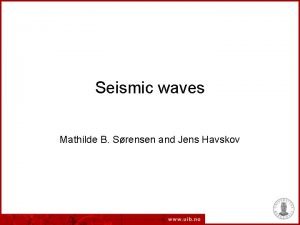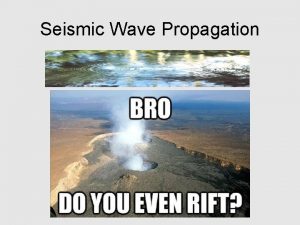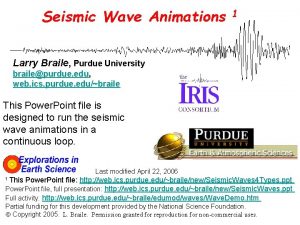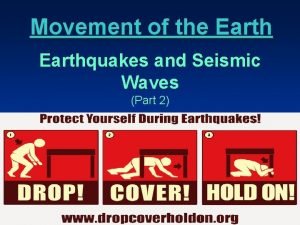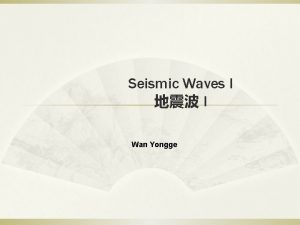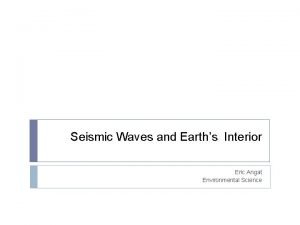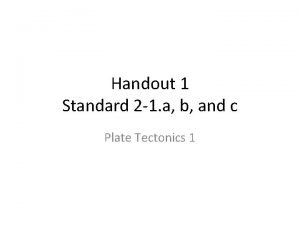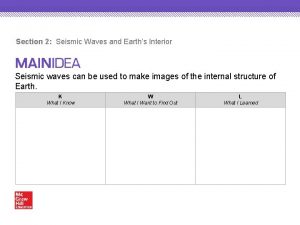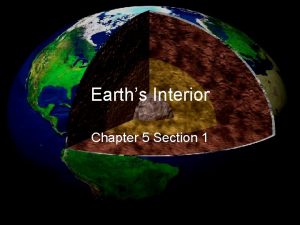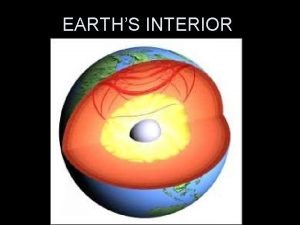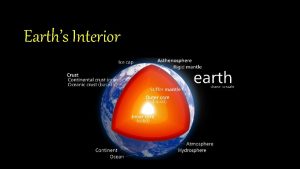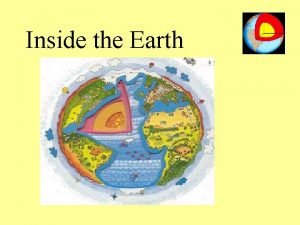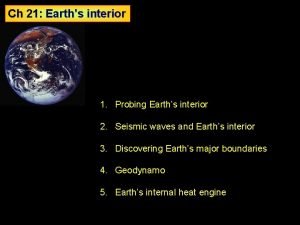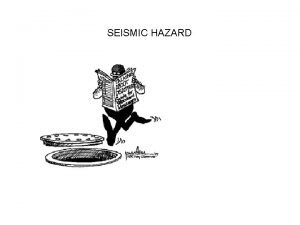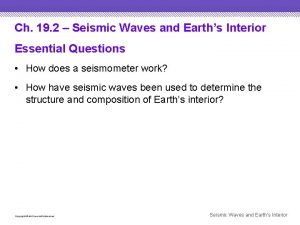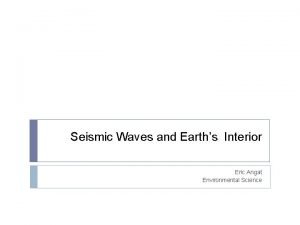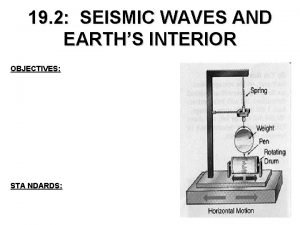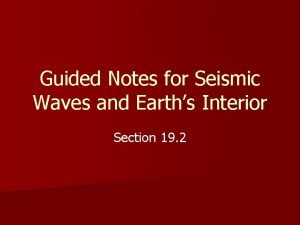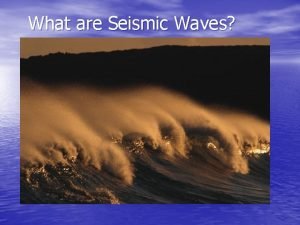Section 2 Seismic Waves and Earths Interior Seismic




















- Slides: 20

Section 2: Seismic Waves and Earth’s Interior Seismic waves can be used to make images of the internal structure of Earth. K What I Know W What I Want to Find Out L What I Learned

Essential Questions • How does a seismometer work? • How have seismic waves been used to determine the structure and composition of Earth’s interior? Copyright © Mc. Graw-Hill Education Seismic Waves and Earth’s Interior

Vocabulary Review New • • • mantle Copyright © Mc. Graw-Hill Education seismometer seismogram Seismic Waves and Earth’s Interior

Seismometers and Seismograms • Most of the vibrations caused by seismic waves cannot be felt at great distances from an earthquake’s epicenter, but they can be detected by sensitive instruments called seismometers, which measure horizontal or vertical motion during an earthquake. Copyright © Mc. Graw-Hill Education Seismic Waves and Earth’s Interior

Seismometers and Seismograms • The frame of a seismometer is anchored to the ground. When an earthquake occurs, the frame moves but the hanging mass and attached pen do not. The mass and pen record the relative movement as the recording device moves under them. Copyright © Mc. Graw-Hill Education Seismic Waves and Earth’s Interior

Seismometers Concepts In Motion FPO Add link to Animation from p. 534 here. Copyright © Mc. Graw-Hill Education Seismic Waves and Earth’s Interior

Seismometers and Seismograms • The record produced by a seismometer that can provide individual tracking of each type of seismic wave is a seismogram. Copyright © Mc. Graw-Hill Education Seismic Waves and Earth’s Interior

Seismometers and Seismograms Travel-time curves • Travel-time curves provide the average time it takes for P- and S-waves to reach seismic stations located at different distances from an earthquake’s epicenter. Copyright © Mc. Graw-Hill Education Seismic Waves and Earth’s Interior

Seismometers and Seismograms Distance from the epicenter • Waves recorded on seismograms from more distant stations are farther apart than waves recorded on seismograms at stations closer to the epicenter. Copyright © Mc. Graw-Hill Education Seismic Waves and Earth’s Interior

Seismometers and Seismograms Distance from the epicenter • The separation of seismic waves on seismograms can be used to determine the distance from the epicenter of an earthquake to the seismic station that recorded the seismogram. Copyright © Mc. Graw-Hill Education Seismic Waves and Earth’s Interior

Clues to Earth’s Interior Earth’s internal structure • Seismic waves change speed and direction when at the boundaries between different materials. • As P-waves and S-waves initially travel through the mantle, they follow fairly direct paths. When P-waves strike the core, they are refracted, which means they bend. Copyright © Mc. Graw-Hill Education Seismic Waves and Earth’s Interior

Clues to Earth’s Interior Earth’s internal structure • To find out what happens to S-waves generated by an earthquake, seismologists first determined that the back-and-forth motion of S-waves does not travel through liquid. They then noticed that S-waves do not travel through Earth’s center. Copyright © Mc. Graw-Hill Education Seismic Waves and Earth’s Interior

Clues to Earth’s Interior Earth’s internal structure • The data collected for the paths and travel times of the waves inside Earth led to the current understanding that Earth has an outer core that is liquid an inner core that is solid. Copyright © Mc. Graw-Hill Education Seismic Waves and Earth’s Interior

P-Waves and S-Waves Concepts In Motion FPO Add link to Animation from p. 536 here. Copyright © Mc. Graw-Hill Education Seismic Waves and Earth’s Interior

Clues to Earth’s Interior Earth’s composition • Seismic waves change their speed as they encounter boundaries between zones of different materials. Copyright © Mc. Graw-Hill Education Seismic Waves and Earth’s Interior

Visualizing Seismic Waves • The travel times and behavior of seismic waves provide a detailed picture of Earth’s internal structure. These waves also provide clues about the composition of the various parts of Earth. Copyright © Mc. Graw-Hill Education Seismic Waves and Earth’s Interior

Visualizing Seismic Waves Concepts In Motion FPO Add link to Animation from p. 537 here. Copyright © Mc. Graw-Hill Education Seismic Waves and Earth’s Interior

Clues to Earth’s Interior Imaging Earth’s interior • Because the speed of seismic waves depends on temperature and composition, it is possible to use seismic waves to create images of structures such as slabs and plumes. In general, the speed of seismic waves decreases as temperature increases. Copyright © Mc. Graw-Hill Education Seismic Waves and Earth’s Interior

Clues to Earth’s Interior Imaging Earth’s interior • Images like this one from Japan are generated by capturing the path of seismic waves through Earth’s interior. Copyright © Mc. Graw-Hill Education Seismic Waves and Earth’s Interior

Review Essential Questions • How does a seismometer work? • How have seismic waves been used to determine the structure and composition of Earth’s interior? Vocabulary • seismometer Copyright © Mc. Graw-Hill Education • seismogram Seismic Waves and Earth’s Interior
 Seismic waves are mechanical waves
Seismic waves are mechanical waves Earths interior
Earths interior Compare and contrast p waves and s waves using venn diagram
Compare and contrast p waves and s waves using venn diagram Mechanical waves and electromagnetic waves similarities
Mechanical waves and electromagnetic waves similarities Mechanical waves and electromagnetic waves
Mechanical waves and electromagnetic waves Mechanical waves and electromagnetic waves similarities
Mechanical waves and electromagnetic waves similarities Short wave vs long wave radiation
Short wave vs long wave radiation Difference between matter waves and electromagnetic waves
Difference between matter waves and electromagnetic waves Similarities of mechanical and electromagnetic waves
Similarities of mechanical and electromagnetic waves Seismic waves
Seismic waves Electromagnetic and mechanical waves
Electromagnetic and mechanical waves Constructive
Constructive Seismic
Seismic Seismic wave front
Seismic wave front Seismic
Seismic Seismic waves animation
Seismic waves animation Seismic wave types
Seismic wave types P wave formula
P wave formula Which type of wave can penetrate the outer and inner core?
Which type of wave can penetrate the outer and inner core? Seismic waves
Seismic waves Define shadow zone
Define shadow zone












